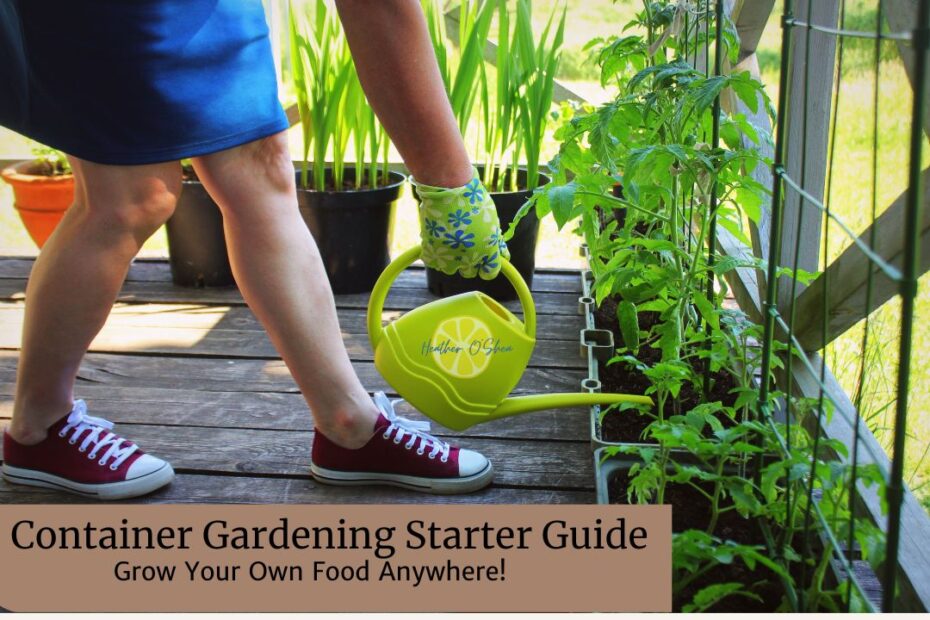Grow Your Own Food Anywhere!
*This post may contain affiliate links and I may earn a small commission when you click on the links at no additional cost to you. As an Amazon Affiliate I earn from qualifying purchases. You can read my full affiliate disclosure here.
Want to grow fresh, delicious food but don’t have a big backyard? Container gardening is the perfect solution! Whether you have a small patio, balcony, or just a sunny windowsill, you can grow herbs, veggies, and even fruit right at home. This guide will help you get started with easy, space-saving gardening tips.
Why Choose Container Gardening?
- Perfect for Small Spaces – Grow food on patios, balconies, or indoors.
- Easier to Maintain – Less weeding, fewer pests, and better control over soil conditions.
- Portable & Flexible – Move plants for better sunlight or protection from weather.
- Great for Beginners – Start small and expand as you gain confidence.
Step 1: Choose the Right Containers
Your container choice will impact plant growth. Here’s what to consider:
- Size Matters: Deeper pots work best for root crops (carrots, potatoes), while shallow containers suit herbs and lettuce.
- Drainage is Key: Always use containers with drainage holes to prevent root rot.
- Material Options:
- Terracotta & Clay: Classic, breathable but can dry out quickly.
- Wooden Planters: Natural look, great for raised beds but may need lining.
- Plastic & Fabric Grow Bags: Lightweight, affordable, and great for retaining moisture.
Step 2: Best Crops for Container Gardening
Some plants thrive in containers better than others. Here are the best beginner-friendly choices:
🌱 Herbs – Basil, parsley, cilantro, chives, mint (use a separate pot for mint—it spreads!).
🍅 Tomatoes – Choose compact varieties like cherry tomatoes or bush tomatoes.
🥬 Leafy Greens – Lettuce, spinach, arugula, kale – quick-growing and space-efficient.
🥕 Root Veggies – Carrots, radishes, and potatoes thrive in deep containers.
🫑 Peppers – Sweet bell peppers or spicy chili peppers grow well in pots.
🍓 Strawberries – Perfect for hanging baskets or vertical planters.
Step 3: Soil & Watering Tips
Healthy plants start with good soil and proper watering.
- Use High-Quality Potting Mix – Garden soil is too dense; choose a well-draining mix designed for containers.
- Feed Your Plants – Use organic fertilizer every few weeks for nutrients.
- Water Smartly – Containers dry out faster than garden beds; check daily in hot weather.
- Mulch for Moisture – Add a layer of mulch to retain water and prevent evaporation.
Step 4: Maximizing Small Spaces
Even with limited space, you can grow a lot! Try these space-saving strategies:
- 🌿 Vertical Gardening – Use trellises, wall planters, or stackable containers for climbing plants like cucumbers or beans.
- 🌾 Hanging Baskets – Great for strawberries, cherry tomatoes, and trailing herbs.
- 🌞 Sunlight Positioning – Most food plants need 6+ hours of sun; place containers accordingly.
- 🚚 Mobile Gardening – Use rolling plant caddies to move pots as needed.
Step 5: Troubleshooting Common Problems
Even small gardens come with challenges! Here’s how to fix common issues:
❌ Yellow Leaves? Overwatering or poor drainage—ensure pots have holes and let soil dry slightly between watering.
❌ Leggy Plants? Not enough sunlight—move to a sunnier spot or use grow lights indoors.
❌ Pests? Use natural deterrents like neem oil or companion planting (e.g., basil repels pests from tomatoes).
Container gardening is an easy, rewarding way to enjoy homegrown food—even in small spaces! Pick one or two plants to start, and you’ll be amazed at how simple and fun it is.
